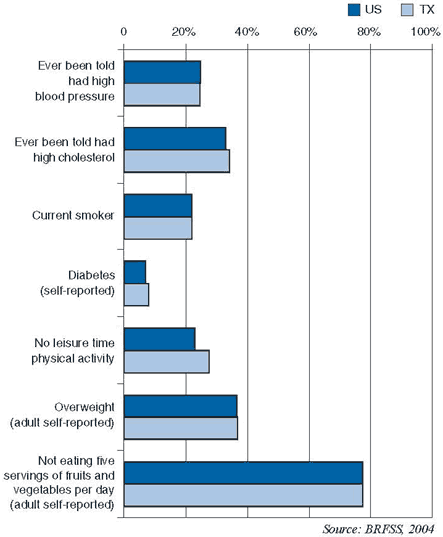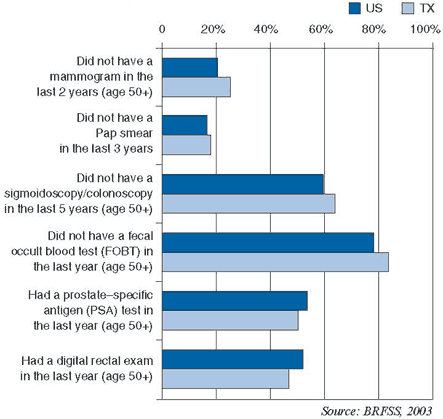|
|
|||||||||||||
|
|
|
|
|
||||||||||
|
|

|
|
|
|
Chronic Diseases: The
Leading Causes of Death
|
|||||||||||||||||||||||||||||||||||||||||||||||||||||||||||||||||||||||||||||||||||||||||||||||||||||||||||||||||||||||||||||||||||||||||||||||||||||||||||||||||||||||||||||||||||||||||||||||||||||||||||||||||||||||||||||||||||||||||||
|
Mortality Rates, 1995 and 2001 *rates per 100,000 |
||||
|---|---|---|---|---|
| United States | Texas | |||
| 1995 | 2001 | 1995 | 2001 | |
| Heart Disease | 280.7 | 245.8 | 222.9 | 202.1 |
| Stroke | 60.1 | 57.4 | 52.3 | 49.7 |
| All cancers | 204.9 | 194.4 | 168.9 | 156.7 |
| Source: National Center for Health Statistics, 2003 | ||||
Chronic diseases—such as heart disease, stroke, cancer, and diabetes—are among the most prevalent, costly, and preventable of all health problems. Seven of ten Americans who die each year, or more than 1.7 million people, die of a chronic disease.
Chronic diseases are not prevented by vaccines, nor do they just disappear. To a large degree, the major chronic disease killers are an extension of what people do, or not do, as they go about the business of daily living. Health-damaging behaviors—in particular, tobacco use, lack of physical activity, and poor nutrition—are major contributors to heart disease and cancer, our nation’s leading killers. However, tests are currently available that can detect breast cancer, colon cancer, heart disease, and other chronic diseases early, when they can be most effectively treated.
Heart disease and stroke are the first and third leading causes of death for both men and women in the United States. Heart disease is the leading cause of death in Texas, accounting for 43,199 deaths or approximately 28% of the state’s deaths in 2001 (the most recent year for which data are available). Stroke is the third leading cause of death, accounting for 10,612 deaths or approximately 7% of the state’s deaths in 2001.
Two major independent risk factors for heart disease and stroke are high blood pressure and high blood cholesterol. Other important risk factors include diabetes, tobacco use, physical inactivity, poor nutrition, and being overweight or obese. A key strategy for addressing these risk factors is to educate the public and health care practitioners about the importance of prevention. All people should also partner with their health care providers to have their risk factor status assessed, monitored, and managed in accordance with national guidelines. People should also be educated about the signs and symptoms of heart attack and stroke and the importance of calling 911 quickly. Forty-seven percent of heart attack victims and about the same percentage of stroke victims die before emergency medical personnel arrive.

| Risk Factors for Cardiovascular Disease | US | TX |
|---|---|---|
| Ever been told had high blood pressure | 24.8% | 24.6% |
| Ever been told had high blood cholesterol | 33.1% | 34.3% |
| Current Smoker | 22.0% | 22.1% |
| People reporting a diagnosis of diabetes | 7.1% | 8.1% |
| No leisure time physical activity | 23.1% | 27.6% |
| Adults who reported being overweight | 36.8% | 36.9% |
| Adults who reported not eating five fruits and vegetables per day | 77.6% | 77.5% |
| Source: BRFSS, 2004 | ||
Cancer is the second leading cause of death and is responsible for one of four deaths in the United States. In 2004, over 560,000 Americans—or more than 1,500 people a day—will die of cancer. Of these annual cancer deaths, 34,830 are expected in Texas. About 1.4 million new cases of cancer will be diagnosed nationally in 2004 alone. This figure includes 84,530 new cases that are likely to be diagnosed in Texas.
| Estimated Cancer Deaths, 2004 | ||
|---|---|---|
| Cause of death | US | TX |
| All Cancers | 563,700 | 34,830 |
| Breast (female) | 40,110 | 2,410 |
| Colorectal | 56,730 | 3,560 |
| Lung and Bronchus | 160,440 | 9,670 |
| Prostate | 29,900 | 1,760 |
| Source: American Cancer Society, 2004 | ||
The number of new cancer cases can be reduced and many cancer deaths can be prevented. Adopting healthier lifestyles— for example, avoiding tobacco use, increasing physical activity, achieving a healthy weight, improving nutrition, and avoiding sun overexposure—can significantly reduce a person’s risk for cancer. Making cancer screening, information, and referral services available and accessible is essential for reducing the high rates of cancer and cancer deaths. Screening tests for breast, cervical, and colorectal cancers reduce the number of deaths by detecting them early.

| Preventive Screening Trends | US | TX |
|---|---|---|
| Did not have a mammogram in the last 2 years | 20.4% | 25.3% |
| Did not have a Pap smear in the last 3 years | 16.7% | 17.9% |
| Did not have a sigmoidoscopy/colonoscopy in the last 5 years ( 50+) | 59.5% | 63.8% |
| Did not have a fecal occult blood test in last year (50+) | 78.2% | 83.6% |
| Had a prostate-specific antigen (PSA) within the last year (50+) | 53.7% | 50.2% |
| Had a digital rectal in the last year (50+) | 52.0% | 46.9% |
| Source: BRFSS, 2003 | ||
In collaboration with public and private health organizations, CDC has established a national framework to help states obtain the information, resources, surveillance data, and funding needed to implement effective chronic disease prevention programs and ensure that all Americans have access to quality health care. CDC funding and support enable state health departments to respond efficiently to changing health priorities and effectively use limited resources to meet a wide range of health needs among specific populations. The table below is a breakdown of the CDC’s funding awards to Texas in the areas of cancer, heart disease, stroke, and related risk factors.
| CDC Cancer, Heart Disease, Stroke, and Related Risk Factor Funding for Texas, FY 2003 | |
|---|---|
| SURVEILLANCE | |
Behavioral Risk Factor Surveillance System (BRFSS)
|
$158,523 |
National Program of Cancer Registries
|
$2,372,058 |
| CHRONIC DISEASE PREVENTION AND CONTROL | |
Cardiovascular Health Program
|
$326,820 |
Diabetes Control Program
|
$1,364,132 |
National Breast and Cervical Cancer Early Detection Program
|
$6,242,251 |
National Comprehensive Cancer Control Program
|
$300,000 |
| WISEWOMAN | $0 |
| MODIFYING RISK FACTORS | |
National Tobacco Prevention and Control Program
|
$952,908 |
State Nutrition and Physical Activity/Obesity Prevention
Program
|
$447,589 |
Racial and Ethnic Approaches to Community Community Health
(REACH 2010)
|
$250,000 |
| Total | $12,414,281 |
| The shaded area(s) represents program areas that are not currently funded. The above figures may contain funds that have been carried over from a previous fiscal year. | |
Additional Funding
CDC’s National Center for Chronic Disease Prevention and Health Promotion funds additional programs in Texas that fall into other health areas. A listing of these programs can be found at http://www.cdc.gov/nccdphp/states/index.htm.
Cardiovascular disease (CVD) has been the leading cause of death in Texas since 1940. In 2001, CVD claimed close to 54,000 lives, which accounts for 2 out of every 5 deaths in the state. According to Texas hospitalization data, in 2001, heart attack, congestive heart failure, and hardening of the heart arteries are among the 10 most frequent causes of hospitalization of people 45 years and older. The economic burden of cardiovascular disease is a major concern: 2 of the 10 most expensive conditions treated in Texas hospitals are heart-related, with charges averaging $65,000.
Cardiovascular disease is the major cause of death among minority populations in Texas. The highest mortality rate is in the African American population. In 2002, the death rate for ischemic heart disease for African Americans was 353 per 100,000 population, compared with 254.7 per 100,000 for whites and 209.6 per 100,000 for Hispanics. Additionally, the 2002 death rate for stroke among African Americans was 90.4 per 100,000, compared to 61.9 per 100,000 for whites and 50.5 per 100,000 for Hispanics.
State initiatives to reduce the prevalence of CVD include the formation of the Texas Council on Cardiovascular Disease and Stroke, which has set goals to reduce CVD mortality by promoting healthy lifestyle choices.
Text adapted from Cardiovascular Disease in Texas: A State Plan with Disease Indicators and Strategies for Action (2000) and Texas Plan to Reduce Cardiovascular Disease and Stroke (2002).
| Healthy Texans 2010 Goals: Reducing Cardiovascular Disease | ||
|---|---|---|
| Risk Factors for Cardiovascular Disease (18 years and older) | Baseline for Texas | Texas 2010 Target |
| Reduce the proportion of adults with high blood pressure | 23.7% | 16% |
| Reduce the proportion of adults with high blood cholesterol | 30.8% | 17% |
| Reduce the number of adults who smoke cigarettes | 22.0% | 12% |
| Reduce the proportion of adults who are physically inactive | 27.8% | 20% |
| Reduce the proportion of obese adults | 25.3% | 15% |
| Source: Healthy Texans 2010 | ||
Hispanics represent approximately 13% of the U.S. population. According to the 2000 Census, this population, which increased by more than 50% from 1990 to 2000, is the fastest growing ethnic group in the nation. Approximately half of the Hispanic population in the United States resides in Texas. The health status of Hispanics in Texas mirrors the health status trends for the Hispanic population throughout the United States.
Nationally, heart disease and cancer were the leading causes of death for Hispanics in 2001. During this period, cardiovascular disease accounted for 27.1% of all deaths among men and 32.6% of deaths among women within this population. According to the American Cancer Society, nationally, Hispanics experience lower rates of cancer incidence and death for all cancers combined. Diabetes prevalence is high within the Hispanic population. According to the American Diabetes Association, 2 million, or 8.2% of all Hispanics in the United States have diabetes, compared with the overall national figure, 7.2%.
In Texas, Hispanics have the lowest mortality rates for lung cancer and colorectal cancers, a higher incidence of cervical cancer, and a higher incidence of diabetes, compared with other racial and ethnic groups in the state.
Page last reviewed: November 14, 2005
Page last modified: November 14, 2005
Content source: National Center for
Chronic Disease Prevention and Health Promotion
|
|
|
||||||||||||
|